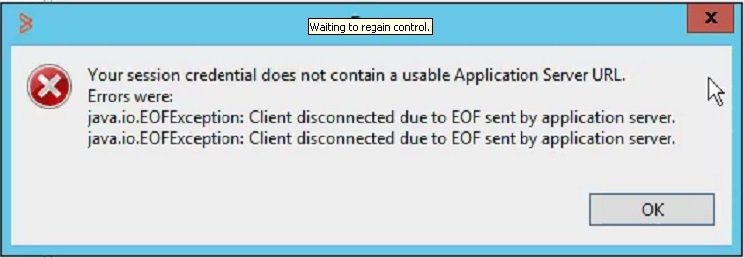Legacy ID:KA316153
This error means the client had a problem connecting to the application server service and the possible causes of this would be that the authentication service's appserviceURL parameter is incorrectly auto-generated/set or the host is not reachable.
To debug this problem and identify the root cause, perform the following steps:
1. Acquire credentials either using the NSH command "blcred cred -acquire" or through the RCP Console and selecting to save credentials during authentication.
2. Run the command "blcred cred -list" (from the machine where the RCP Console is installed) or through the Console view the session credential within the login panel. To do this in the login panel, click Options and choose the Credentials tab. Click on the credential listed and click View.
Observe the hostname listed for "appsvc.bladelogic". Make sure the hostname (name of the appserver) is accurate and RCP console can resolve the hostname (try to ping this hostname from the client).
* If the hostname is incorrect, then from the appserver, run the command "blasadmin show authserver appservice" and confirm if "AppServiceURLs" is set to a value or empty string.
If the value is empty, then the value is auto-generated at authentication time.
You have the option to modify this option to set a specific value or set no value and a URL will be automatically generated. For an auto-generated value run:
blasadmin set authserver AppServiceURLs ""
Or an explicit value can be set:
blasadmin set authserver AppServiceURLs "service:appsvc.bladelogic:blsess://<servername>:<port>"
This option is covered in detail in the TSSA Administration Guide. If the auto-generated hostname is incorrect this could be because the hosts file on the appserver has its own IP Address mapped to the incorrect hostname or DNS reverse lookup is not returning the correct hostname value.
* If the hostname is correct but the client cannot resolve the hostname, try adding an entry in the hosts file of the client so the hostname will resolve to the correct IP address.
3. If the information above is correct and the client can resolve the hostname, there could be other reasons that it is not working. Check the appserver.log for any additional error information. If you see an error about mismatching URLs, it could be that the appserver was resolving its IP address to its shortname but expecting a fully qualified hostname. In this case you would see an error hinting at URL mismatch showing the expected and actual values. This can happen if the hosts file on the appserver has an entry which is correct but the hostname listed is either just the shortname, just the fully qualified hostname or both but in a certain order. If only one name is listed, add the other, so the related entry looks like::
<IP Address> <FQDN> <shortname>.
If both the shortname and fully qualified name are present, try reversing their order.
4. If hostname resolution appears to be working correctly, also confirm the appserver is listening on the appservice port. First verify the appservice port by running on the appserver:
blasadmin show appserver appsvcport
and then verify the port is being listened on by running this command from an NSH shell also on the appserver:
netstat -an | grep <appserver port number>
It should list one line as listening. If you don’t see it stop the appserver service, make sure all corresponding processes are stopped (or kill them) and restart the appserver. Run netstat again to make sure the service is running now. If the specified appsvcport is still not listening, check the application server log for this appserver to see if there were issues during startup.
5. Once it has been verified that the specified appsvcport is listening on the appserver but the problem persists, verify the client can connect to the specified appsvcport port. To check this perform the following:
* ping appserver hostname from the client and confirm if there is a reply
* telnet to the appserver host/port from the client.
i.e.
telnet myappserver.bmc.com 9841
If this is successful telnet will connect. Nothing will be printed on the screen but you will be able to type at least some characters and terminate the connection.. If the telnet command fails, make sure there is no firewall between the client and appserver which will prevent this communication.
6. If the console is showing the following error, check 'appserver.log' on the appserver to check the error message, make sure that the appserver is up and running.

Other possible causes include TSSA database user password getting expired or reset on the DB end.